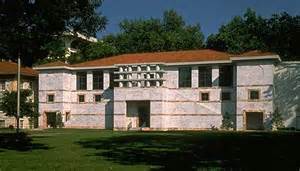Aug 19 2017 - Dec 17 2017
Michael C. Carlos Museum at Emory University
Atlanta, GA
The Carlos Museum will showcase its remarkable textile collection in Threads of Time: Tradition and Change in Indigenous American Textiles. The exhibition explores the staggering breadth and depth of indigenous American fiber arts ranging from weavings in cotton and camelid hair, to feather work and items made from plants. The museum’s permanent collection contains over 700 examples, of which 149 will be on display, many for the first time.
Fiber arts were of the highest importance among the First Nations, or indigenous peoples of the Americas. Ancient Andean as well as modern Andean, Panamanian, and Guatemalan cultures will be featured in the exhibition, including a wide range of techniques such as three-dimensional embroidery, tie-dye, brocade, and tapestry. The exhibition will explore how these beautiful and complex textiles embody the traditional values, materials, and ideas of their respective indigenous cultures, while also embracing new techniques, imagery, and types of objects as they change during colonial and modern times.
The Andean coastal desert preserves very ancient fibers--one piece in the exhibition is nearly 2000 years old--which will allow visitors to appreciate the world’s longest continuous textile record. Values embedded in the Quechua language, spoken by the Inka and millions of their descendants, can be traced even as guitars, horses, and other Western elements entered the artistic vocabulary. The Guna of coastal and island Panama maintain a link to age-old indigenous design in their cut-cloth blouse panels (dulemola), yet they incorporate contemporary imagery such as the Trix Rabbit. The Maya of Guatemala have always created extraordinary garments for themselves, and more recently for sculptures of Catholic saints. The large selection of Maya textiles in the exhibition includes brocaded blouses from the town of Chichicastenango as they transformed during the 20th century, as well as examples of the varying degrees of Spanish influence in wedding dress, male clothing, and altar cloths.
Credit: Exhibition overview from museum website
Whether or not you go, To Weave for the Sun: Ancient Andean Textiles celebrates the textiles of the Incas, their most prized possessions. Their first gifts to European strangers were made not of gold and silver, but of camelid fibre and cotton. They believed that the highest form of weaving was created expressly for the sun, which they considered the greatest of the celestial powers. This book uses this image to symbolize Andean tradition as a whole. Described and illustrated here, in many cases for the first time, are the finest examples: weavings of astonishing virtuosity with striking geometric designs, elaborate carpets and covers, mantles, tunics, featherwork, woven shoes with metal decoration and intriguing figural sculptures with tapestry faces - representing the major cultures of the pre-Columbian period as well as the achievements of Spanish Colonial times. A chronological overview and accompanying essays examine the weavings as primary sources of information about their makers. For archaeologists, ethnographers, textile designers and weavers and all those who appreciate the brilliant artistry of ancient civilizations, the achievement of the weaver as creative artist is both celebrated and explored.
Exhibition Venues & Dates
Aug 19 2017 - Dec 17 2017
Michael C. Carlos Museum at Emory University
Atlanta, GA

